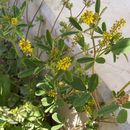en
names in breadcrumbs


Nile region, Oases, Mediterranean region, Egyptian desert and Sinai.
Mediterranean region, Eurasia; Introduced and naturalized elsewhere.

Melilotus indicus, sometimes incorrectly written Melilotus indica, is a yellow-flowered herb native to northern Africa, Europe and Asia, but naturalized throughout the rest of the world.
Common names in English include sweet clover (or sweet-clover), sour clover (sour-clover, sourclover), Indian sweet-clover, annual yellow sweetclover, Bokhara clover, small-flowered sweet clover, common melilot, small-flowered melilot, small melilot, sweet melilot, Californian lucerne and Hexham scent. In Australia and New Zealand, where it is naturalised, it is sometimes called King Island melilot or King Island clover.[1][2][3]
It is an annual or biennial herb from 10 to 50 centimetres (3.9 to 19.7 inches) in height (rarely to one metre), with trifoliate leaves and small yellow flowers borne in dense racemes.[4] Similar to Melilotus altissima Thuill. in general. The flowers are 2 – 3 mm long and produce a hairless pod of similar length.[5] Its leaves have a sweet, cloying scent when crushed.
It was first published as Trifolium indicum by Carl Linnaeus in his 1753 Species plantarum. It was transferred into Melilotus by Carlo Allioni in 1785.[6]
It has a wide native distribution, ranging from Macaronesia and northern Africa, through Europe, and into temperate and tropical Asia. It is naturalised throughout most of the rest of the world, including the United Kingdom, the United States, South America, Australia and New Zealand.[1]
It is used as a source of nectar for bees, as forage, and as a soil improver. It is also used in folk medicine. It is poisonous to some mammals, and is a potential seed crop contaminant.[1]
In Pakistan, Melilotus indicus is called sinji, which is used as a vegetable. It has many medicinal uses. It has antioxidant properties [1]. It also has alpha-amylase inhibitory activities [2], because of which it may be useful for type 2 diabetes.
 Melilotus indicus - MHNT
Melilotus indicus - MHNT Melilotus indicus, sometimes incorrectly written Melilotus indica, is a yellow-flowered herb native to northern Africa, Europe and Asia, but naturalized throughout the rest of the world.
Common names in English include sweet clover (or sweet-clover), sour clover (sour-clover, sourclover), Indian sweet-clover, annual yellow sweetclover, Bokhara clover, small-flowered sweet clover, common melilot, small-flowered melilot, small melilot, sweet melilot, Californian lucerne and Hexham scent. In Australia and New Zealand, where it is naturalised, it is sometimes called King Island melilot or King Island clover.